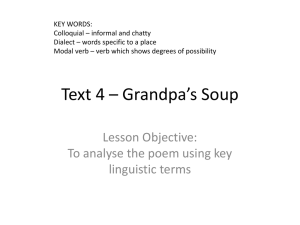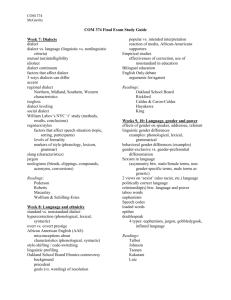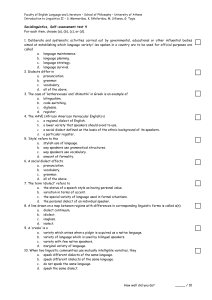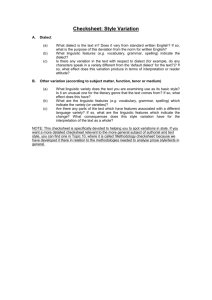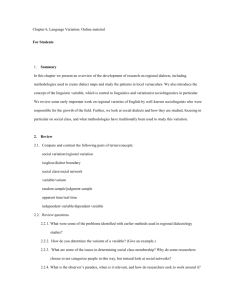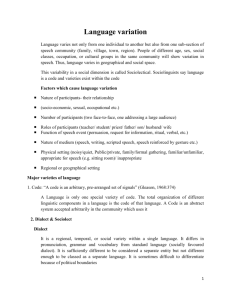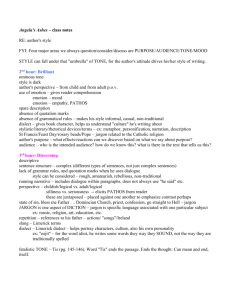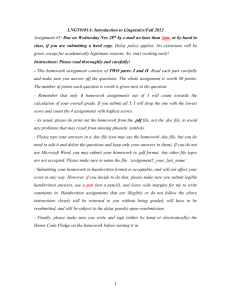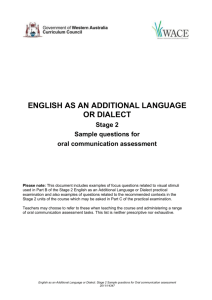di•a•lect dictionary
advertisement
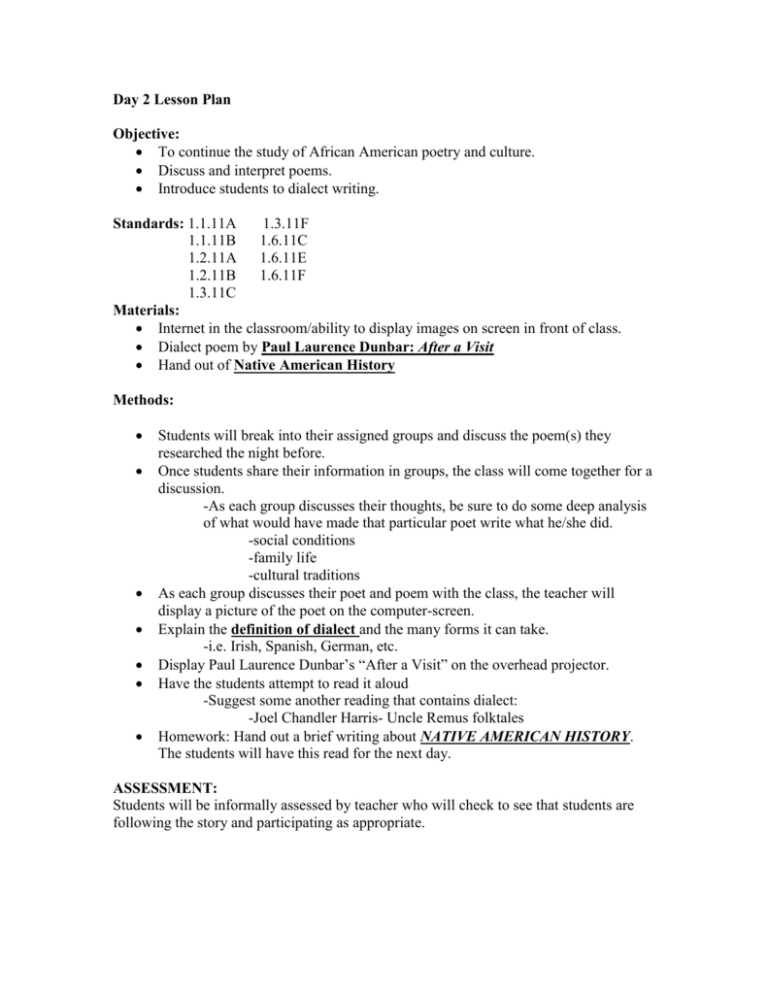
Day 2 Lesson Plan Objective: To continue the study of African American poetry and culture. Discuss and interpret poems. Introduce students to dialect writing. Standards: 1.1.11A 1.3.11F 1.1.11B 1.6.11C 1.2.11A 1.6.11E 1.2.11B 1.6.11F 1.3.11C Materials: Internet in the classroom/ability to display images on screen in front of class. Dialect poem by Paul Laurence Dunbar: After a Visit Hand out of Native American History Methods: Students will break into their assigned groups and discuss the poem(s) they researched the night before. Once students share their information in groups, the class will come together for a discussion. -As each group discusses their thoughts, be sure to do some deep analysis of what would have made that particular poet write what he/she did. -social conditions -family life -cultural traditions As each group discusses their poet and poem with the class, the teacher will display a picture of the poet on the computer-screen. Explain the definition of dialect and the many forms it can take. -i.e. Irish, Spanish, German, etc. Display Paul Laurence Dunbar’s “After a Visit” on the overhead projector. Have the students attempt to read it aloud -Suggest some another reading that contains dialect: -Joel Chandler Harris- Uncle Remus folktales Homework: Hand out a brief writing about NATIVE AMERICAN HISTORY. The students will have this read for the next day. ASSESSMENT: Students will be informally assessed by teacher who will check to see that students are following the story and participating as appropriate. DEFINITION OF DIALECT di·a·lect dictionary.com 1. a. A regional or social variety of a language distinguished by pronunciation, grammar, or vocabulary, especially a variety of speech differing from the standard literary language or speech pattern of the culture in which it exists: Cockney is a dialect of English. b. A variety of language that with other varieties constitutes a single language of which no single variety is standard: the dialects of Ancient Greek. 2. The language peculiar to the members of a group, especially in an occupation; jargon: the dialect of science. 3. The manner or style of expressing oneself in language or the arts. 4. A language considered as part of a larger family of languages or a linguistic branch. Not in scientific use: Spanish and French are Romance dialects. DIALECT POEM By PAUL LAURENCE DUNBAR AFTER A VISIT I BE'N down in ole Kentucky Fur a week er two, an' say, 'T wuz ez hard ez breakin' oxen Fur to tear myse'f away. Allus argerin' 'bout fren'ship An' yer hospitality-Y' ain't no right to talk about it Tell you be'n down there to see. See jest how they give you welcome To the best that 's in the land, Feel the sort o' grip they give you When they take you by the hand. Hear 'em say, "We 're glad to have you, Better stay a week er two;" An' the way they treat you makes you Feel that ev'ry word is true. Feed you tell you hear the buttons Crackin' on yore Sunday vest; Haul you roun' to see the wonders Tell you have to cry for rest. Drink yer health an' pet an' praise you Tell you git to feel ez great Ez the Sheriff o' the county Er the Gov'ner o' the State. Wife, she sez I must be crazy 'Cause I go on so, an' Nelse He 'lows, "Goodness gracious! daddy, Cain't you talk about nuthin' else?" Well, pleg-gone it, I 'm jes' tickled, Bein' tickled ain't no sin; I be'n down in ole Kentucky, An' I want o' go ag'in. NATIVE AMERICAN HISTORY NATIVE AMERICAN CULTURES The America that greeted the first Europeans was, thus, far from an empty wilderness. It is now thought that as many people lived in the Western Hemisphere as in Western Europe at that time -- about 40 million. Estimates of the number of Native Americans living in what is now the United States at the onset of European colonization range from two to 18 million, with most historians tending toward the lower figure. What is certain is the devastating effect that European disease had on the indigenous population practically from the time of initial contact. Smallpox, in particular, ravaged whole communities and is thought to have been a much more direct cause of the precipitous decline in Indian population in the 1600s than the numerous wars and skirmishes with European settlers. Indian customs and culture at the time were extraordinarily diverse, as could be expected, given the expanse of the land and the many different environments to which they had adapted. Some generalizations, however, are possible. Most tribes, particularly in the wooded eastern region and the Midwest, combined aspects of hunting, gathering and the cultivation of maize and other products for their food supplies. In many cases, the women were responsible for farming and the distribution of food, while the men hunted and participated in war. By all accounts, Indian society in North America was closely tied to the land. Identification with nature and the elements was integral to religious beliefs. Indian life was essentially clan-oriented and communal, with children allowed more freedom and tolerance than was the European custom of the day. Although some North American tribes developed a type of hieroglyphics to preserve certain texts, Indian culture was primarily oral, with a high value placed on the recounting of tales and dreams. Clearly, there was a good deal of trade among various groups and strong evidence exists that neighboring tribes maintained extensive and formal relations -- both friendly and hostile.
